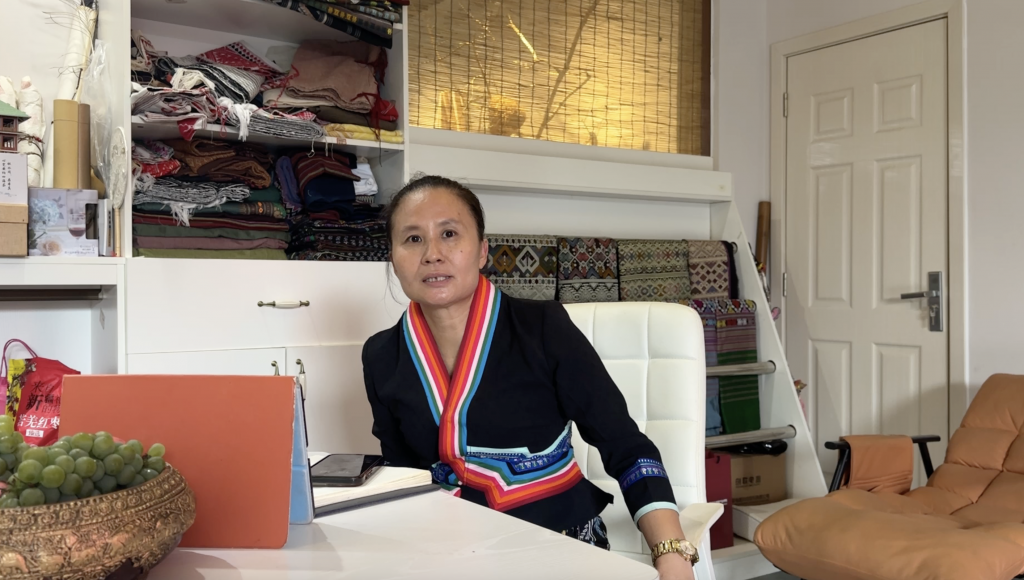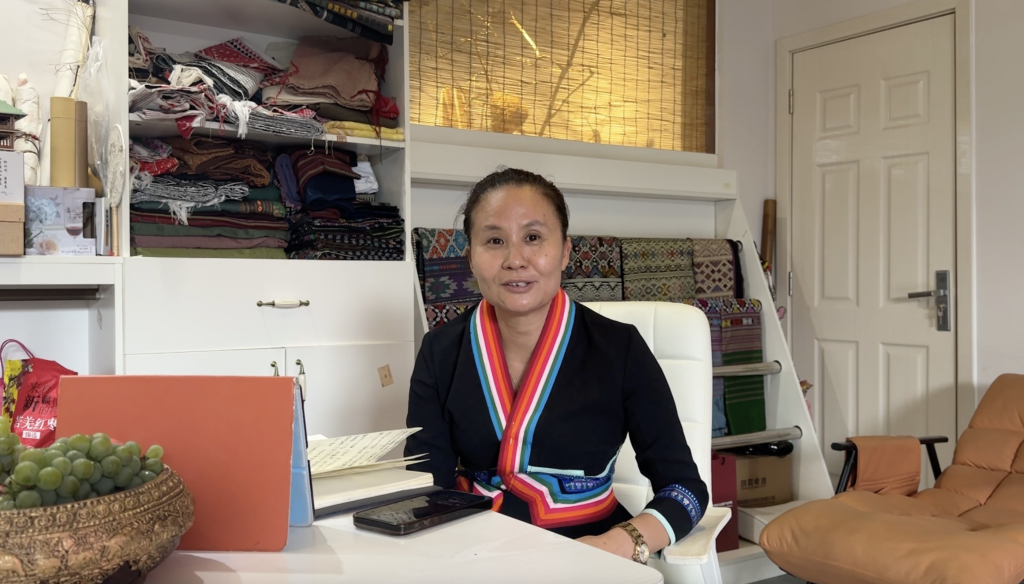
Because of the dengue virus, I didn’t go to Xishuangbanna Autonomous Prefecture at that time. I asked my cousin to visit the inheritor of Yunnan intangible cultural heritage – Ai Mi on my behalf. In the 20 years she has been the inheritor, she has always upheld the concept of respecting tradition. In a previous interview with Yunnan TV, she said, “The concept of tradition is not what others call daily clothing, but the most primitive things at that time, and the most primitive national culture is in it. Only by digging into the roots of culture and integrating it can it be truly traditional clothing.”
- Can you briefly introduce yourself?
I am Yan (pronounced as Ai in Dai language), a Dai ethnic minority clothing designer. I have been engaged in Dai ethnic clothing for more than 20 years. I am also a cultural inheritor of Dai clothing.
- Can you briefly introduce the ethnic characteristics of the Dai people?
As far as I know, there are three obvious characteristics of Dai ethnic culture.
The first one: There are only a few main surnames for Dai men and women. The characteristics of the Dai people can be seen from their names, which are all related to the older generation of the tribe. The second one: The most important festival of the Dai people is the Water Splashing Festival, which is like the Spring Festival of the Han people, indicating that the new year is coming. Other important festivals are the Closing Festival (no marriage and moving into a new house) and the Opening Festival (marriage and moving into a new house are allowed). In addition, there is the Stringing Festival, on which the most respected elders in the village will be asked to tie a string for the younger generation. The third one: The religious culture of the Dai people is Theravada Buddhism.

- What do you think are the characteristics of Dai costumes? Can you give some examples?
The Dai people are divided into three branches (Han Dai, Shui Dai, Huayao Dai). They were divided according to the areas where they lived at that time. People in different areas have different dressing habits. Among the three, Shui Dai is the most common. For example, what I am wearing is Shui Dai costume, which is characterized by a short upper body and a long lower body. The upper body top is tight to the waist, and the lower body is a tube skirt. Now in Xishuangbanna Autonomous Prefecture and Dehong Autonomous Prefecture, the characteristics of the Dai people may be more likely to wear white short clothes and tube skirts.
- On what occasions do you think Dai costumes are worn?
During local Dai festivals, Dai women will wear very grand Dai costumes to appear. Another is that they will also wear their Dai costumes during large-scale events such as weddings. Sometimes, government departments and institutions will also wear ethnic costumes at important meetings. So the Dai people still attach great importance to local costumes.
- Have you observed that the younger generation of the Dai people still wear traditional Dai costumes?
Yes, but not very often. Now, young people tend to wear more Dai-style costumes in their daily lives.
- What do you think of foreigners wearing traditional Chinese costumes or borrowing traditional Chinese cultural elements?
I think that what is national is also global. I am still very proud when I see foreigners wearing clothes of our Chinese ethnic minorities. Now there are many luxury brands abroad that use traditional Chinese elements to integrate into their products, but if they conduct in-depth research on the elements without cultural appropriation and mark them as borrowed elements, I can still accept it!
- How do you think the Dai culture can be spread internationally?
First, increase activities related to cultural exchanges, and then use more modern new media to spread them. Now there are so many new media platforms, which will not only make China and the world know more about the Dai people.
- How do you think the intangible cultural heritage of the Dai people can be better inherited?
The intangible cultural heritage of the Dai people needs to be protected and passed on, but it can be developed and innovated under the premise of respecting the culture. Speaking of inheritance, this involves a platform for exploring and displaying national culture. For example, an immersive cultural experience, or bringing this culture into the campus, so that young people can understand our Chinese intangible cultural heritage. Intangible cultural heritage can also be used to create its academic value, which is very good.
- What impact will it have on the Dai people if the Dai culture exchanges and integrates with foreign cultures? (What kind of respect and understanding do you think the public should have when they meet the Dai culture?)
Because the Dai people have their etiquette, as well as some cultures that need to be avoided. This involves sensitive areas in culture. For example, we must respect the religious beliefs of the Dai people, which they respect very much, and we need to pay special attention when we do cultural exchanges. The second is to abide by the etiquette of the Dai people. The Dai people are more gentle than other ethnic groups. There is also respect for local culture. For example, you cannot drink the well water in the Dai village, you cannot wear a hat in the house, etc. These are all taboos for the locals. Since we are doing cultural exchange, we should respect the living habits of local people and avoid doing things that are disrespectful to local people.
———————————————————————————

Ai Mi then took me to visit her studio with the camera, and showed me the clothes of the former royal family and the clothes of the contemporary Dai people. From this communication with Ai Mi, I can feel her love and pride in the industry she is engaged in.